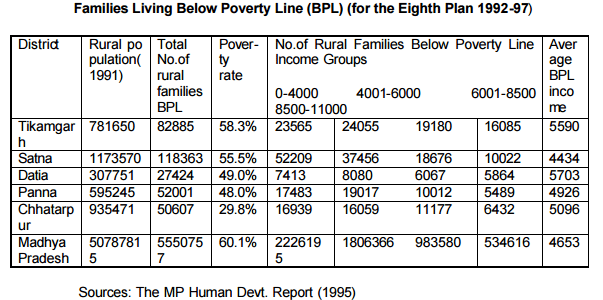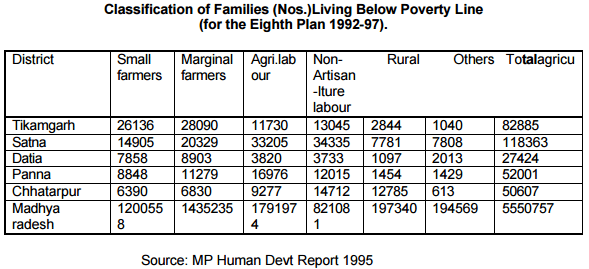Study on Bundelkhand of Planning Commission: Aspects of Economy - Poverty, Income and Quality of Life
Study on Bundelkhand of Planning Commission: Aspects of Economy - Poverty, Income and Quality of Life
Poverty, Income and Quality of Life.
Poverty is rampant in the districts of Bundelkhand. Low productivity in agriculture and industrial backwardness, together with the dying traditional household/cottage industries have kept the region as one of the most poverty stricken. Employment and income generation programmes run by government, hardly reach to the poor in the feudal set up of the society, widely prevalent in the area. Migration to other states doesn’t always solve the
Poverty andquality of life in BundelkhandCase Note No.4 Village- Khairi, Panchayat-Khairi ,Distt:Chhatarpur.Village- Khari is situated in block Chhatarpur on Chhatarpur-Khajuraho road, some 20 km away from Chhattarpur. There are about 450 household with apopulation of around 2000. The village is inhabited by Brahmins, Thakurs,
Dhobi andHarijans. Brahmins are dominant here due to their social,
economic and political status.Nothing can be done in the village
without their influence. About 70% of the land is inthe hand of
Brahmins. Some land, given by the govt., is also with the Harijans,
but due tolack of resources they give their land to landlords for
some money, which covers their travel expenses to go to other cities
or statesfor livelihood. 30 families are almostlandless. Dhobi
community has around 30 families Among the forest products, Mahuwa is available
but in verysmall quantity. Even this is sold to the local sahukar
(trader) on very cheap rate. Thesesahukars also buy the agricultural
produce from the villagers on relatively cheap rate andvillagers are
bound to sell it because There are two sources of loan/credit for the
villages. One ofthem is from banks, but its lengthy processes
discourage poor villagers to take advantageof it, while rich farmers
are well able to avail it. Poor people take loans from feudalrich to
whom the interest upto 25% is When discussing about the role of sarpanch in
villagedevelopment, people noted that in the whole region,
illiterate sarpanchs are under thecontrol of the local MLA who runs
the affairsas he wishes. |
problem of everybody, when the population living below poverty line is very large. That is why there are reports in the local newspapers as well as national news magazines that a large number of poor people are silently dying out of hunger in Bundelkhand. Tikamgarh has poverty rate of 58.3% closely followed by district Satna with 55.5. Districts Datia and Panna also have the poverty rate indicating nearly half of its population below poverty line. Only Chhatarpur is relatively better in Bundelkhand, with the poverty rate of only 29.8% which may be attributed to comparatively loose feudal control and prevelent economic activcities like bidi making. (see table ). Per capita income of the concerned districts is also very low. Human Development Report of MP, 1995, indicates that it is difficult to calculatge the income at the district level and it would not be adequaate indicator for judging the backwardness of the district, but its calculations have some meaning. Chhatarpur, Tikamgarh, Panna and Satna have the per capita income less than Rs3000 per annum. Datia has the per capita income of Rs3238 which is the best among the concerned districts.
Poverty and quality of life in BundelkhandCase Note 5: Village- Bauri, Panchayat- Bauri, Distt:Tikamgarh.Village Bauri is situated in block Tikamgarh, some 4 kms away from the district headquarters. The closeness with the town doesn’t change the living condition of the villagers too much. The village is inhabited by around 690 people belonging mostly to Harijan, Yadav and Kadi castes. Most of the people, particularly of Yadav castes, are involved in agriculture or selling milk to the town areas. Other have got either no land or very little, which is economically not viable due to lack of irrigation facilities. The sarpanch of the village is a Harijan but he is under the influence of powerful people at district headquarters. So close to the town, rather district headquarters, the village is not properly linked in terms of road and transport. If such is the condition of this village, what to tell of far off villages of far off blocks. For drinking water, villagers have to depend on the open wells and three handpumps, which are mostly non functional at intervals. There is a primary school in the village. After primary, girls are not sent to higher schools. Villagers told that for last 5 years, no girl has reached to class 8 in the village. For literacy programme, no female volunteer was available in the village, because no one was so literate to act as volunteer. Poor women are involved mostly in farm or non-farm wage labour. The practice like child marriage was widely prevalent in the village. Most of the girls are sent into marriage before reaching the age of 15. Boys are also married at a very young age. For fully adult girl or boy, it is difficult to get a match for marriage because most of them are married at a young age. The interest rate on the loans/credit taken from
the landlord is as equally exploitative as in the other districts of
Bundelkhand. Efforts are needed to make people aware of the
exploitation involved in money lending business and give them
suitable options in the form of banks, cooperatives and
self-help-groups with easy processes to operate with. |


Quality of life in Bundelkhand is reflected by the prevalence
of diseases,high mortality rate, atrocities against women, poor linkages by
roads and lack of sanitation at the household level.. Though Datia, Tikamgargh
and Chhatarpur have almost all of its villages connected with electricity but
its actual benefits are for a rich few. Poor and marginalised households hardly
have electricity connections. Availability of electricity for rural areas is
also a big question. Panna and Satna districts have not been able to
electrificate all of its villages, where only 68.78 and 73.23 percent of
villages, respectively ,have got connected. Roads to the rural areas are also in
bad conditions. Rural areas are unapproachable for quite a considerable period
of time during the year. Poor connection through roads to service centres like
Primary Health Centres and lack of transport facilities cause a number of losses
in terms of deaths, particularly that of pregnant women and children. The
general usual living-patterns of villages of the districts of Bundelkhand are
given in the form of a few cases (see case notes).
